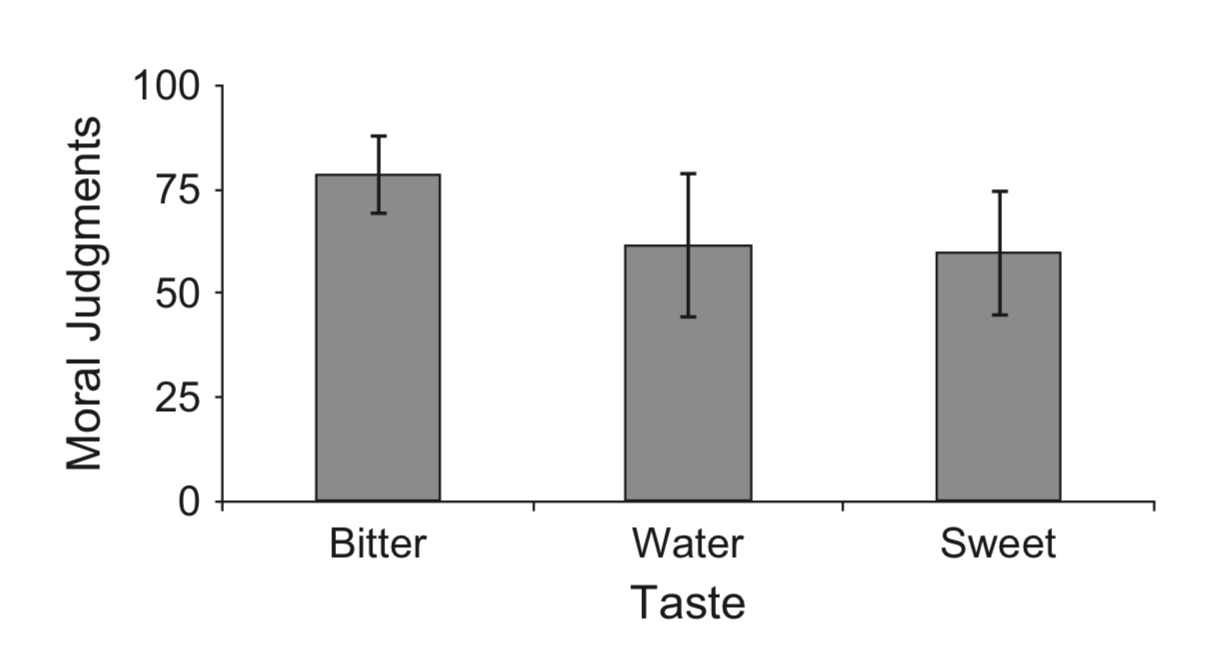Click here and press the right key for the next slide.
(This may not work on mobile or ipad. You can try using chrome or firefox, but even that may fail. Sorry.)
also ...
Press the left key to go backwards (or swipe right)
Press n to toggle whether notes are shown (or add '?notes' to the url before the #)
Press m or double tap to slide thumbnails (menu)
Press ? at any time to show the keyboard shortcuts

Moral Intuitions and Emotions: Evaluating the Evidence
Q: What do adult humans compute that enables their moral intuitions to track moral attributes (such as wrongness)?
Hypothesis:
They rely on the ‘affect heuristic’: ‘if thinking about an act [...] makes you feel bad [...], then judge that it is morally wrong’.
But is the Hypothesis true?
Prediction:
if you make people feel bad (/good) without them realising it, they will be more (/less) inclined to judge that something is morally wrong.
Evidence:
Schnall et al., 2008
✓
Has the study been replicated?
Experiment 1 is successful a replication of Wheatley & Haidt (2005) (good).
Ugazio, Lamm, & Singer (2012) report a failure to replicate Experiment 1 (but with an extraneous change in method).
Johnson et al. (2016) report a convincing failure to replicate Experiment 3 (the one where participants recall a disgusting event in their own lives).
Are there similar studies? If so, are the findings convergent?

Eskine et al, 2011 figure 1
✓
Are there similar studies? If so, are the findings convergent?
Has the study featured in a review? If so, does the review broadly support the findings of this study?

Chapman & Anderson, 2013 table 2
‘To date, almost all of the studies that have manipulated disgust or cleanliness have reported effects on moral judgment. These findings strengthen the case for a causal relationship between disgust and moral judgment, by showing that experimentally evoked disgust—or cleanliness, its opposite—can influence moral cognition’
Chapman & Anderson (2013, p. 313)
UPDATE
‘a recent meta-analysis of disgust induction studies suggests that incidental disgust has at best a small effect on moral judgment (Landy & Goodwin, 2015).’
Chapman (2018, pp. 73–4)
✓
Has the study featured in a review? If so, does the review broadly support the findings of this study?
Q: What do adult humans compute that enables their moral intuitions to track moral attributes (such as wrongness)?
Hypothesis:
They rely on the ‘affect heuristic’: ‘if thinking about an act [...] makes you feel bad [...], then judge that it is morally wrong’.
But is the Hypothesis true?
Prediction:
if you make people feel bad (/good) without them realising it, they will be more (/less) inclined to judge that something is morally wrong.
Evidence:
Schnall et al., 2008
How to evaluate a hypothesis
1. Never trust a philosopher.
2. Is it really evidence?
a. Has the study been replicated?
b. Are there similar studies? If so, are the findings convergent?
c. Has the study featured in a review? If so, does the review broadly support the findings of this study?
Can we reject the Affect Hypothesis?
yes
It’s not just that there is a lack of evidence for it ...
... there is also positive evidence that disgust has at most a small effect on moral judgements (Landy & Goodwin, 2015).
no
small ≠ none
The Hypothesis about intuition but the evidence is about judgement.
Small effect size may be due to less sensitive measures.
Newer research supports a link between disgust and moral judgement (e.g. Tracy, Steckler, & Heltzel, 2019)
Resume
You have a friend who has been trying to find a job lately without much success. [...] He decided to put some false information on his resume [...]. By doing this he ultimately managed to get hired, beating out several candidates who were actually more qualified than he. How wrong was it for your friend to put false information on his resume in order to help him find employment?

my job vs your job
What I will assume for the rest of the lectures ...
0. For now, we cannot rely on the results of Schnall, Haidt, et al. (2008).
1. Feelings of disgust can, and sometimes do, influence some moral intuitions (Tracy et al., 2019).
2. We feel disgust in response to moral transgressions.
Aside
Does disgust influence moral evaluations?
- Manipulate Disgust and Measure Morality (Tracy et al., 2019)
Are moral violations disgusting?
- Manipulate Morality and Measure Disgust (Chapman, Kim, Susskind, & Anderson, 2009)
What I will assume for the rest of the lectures.
0. For now, we cannot rely on the results of Schnall, Haidt, et al. (2008).
1. Feelings of disgust can, and sometimes do, influence moral intuitions.
2. We feel disgust in response to moral transgressions.
Also: we seem to need a better theoretical framework
puzzle
Why do feelings of disgust sometimes influence moral intuitions?
(And why do we feel disgust in response to moral transgressions?)